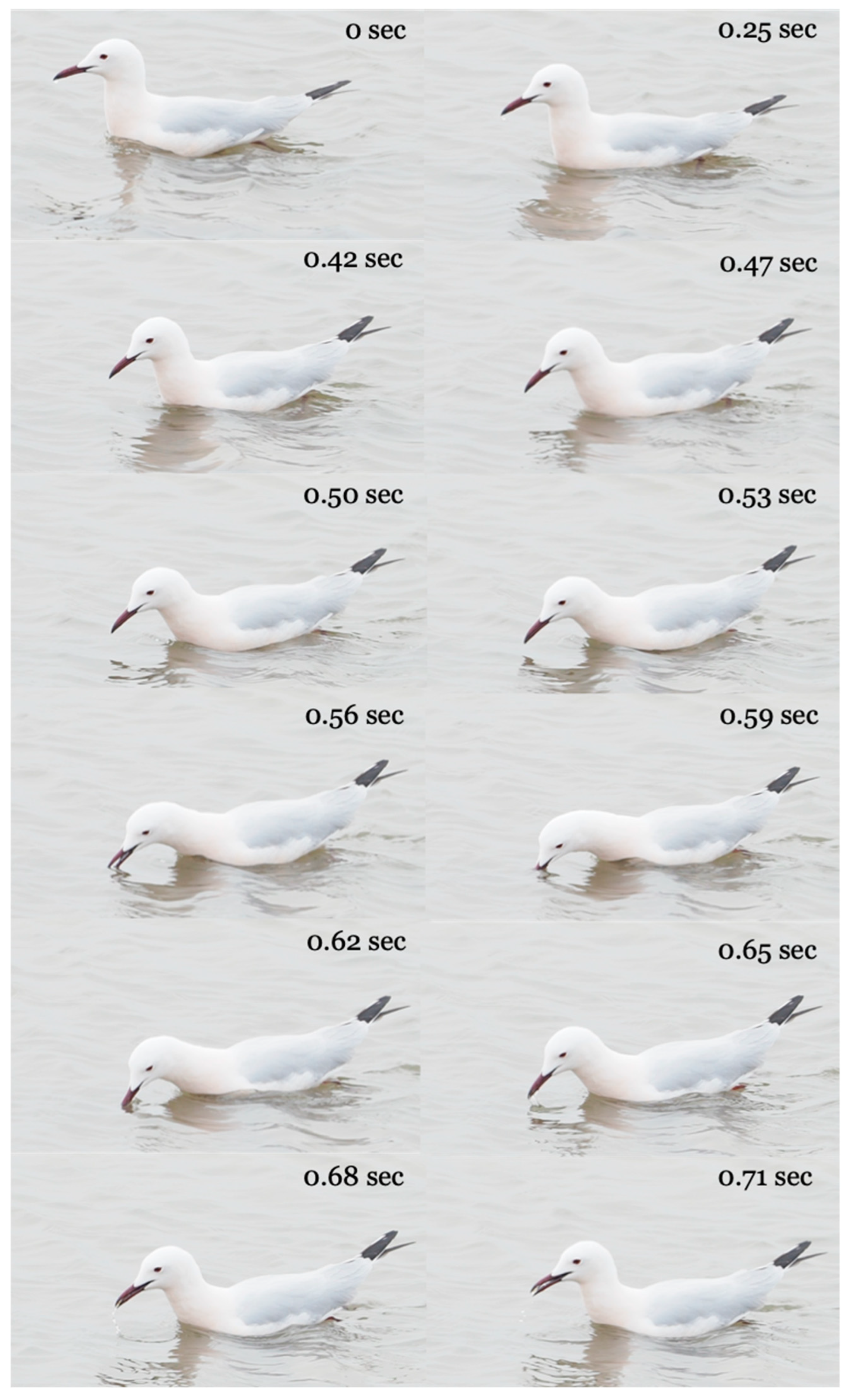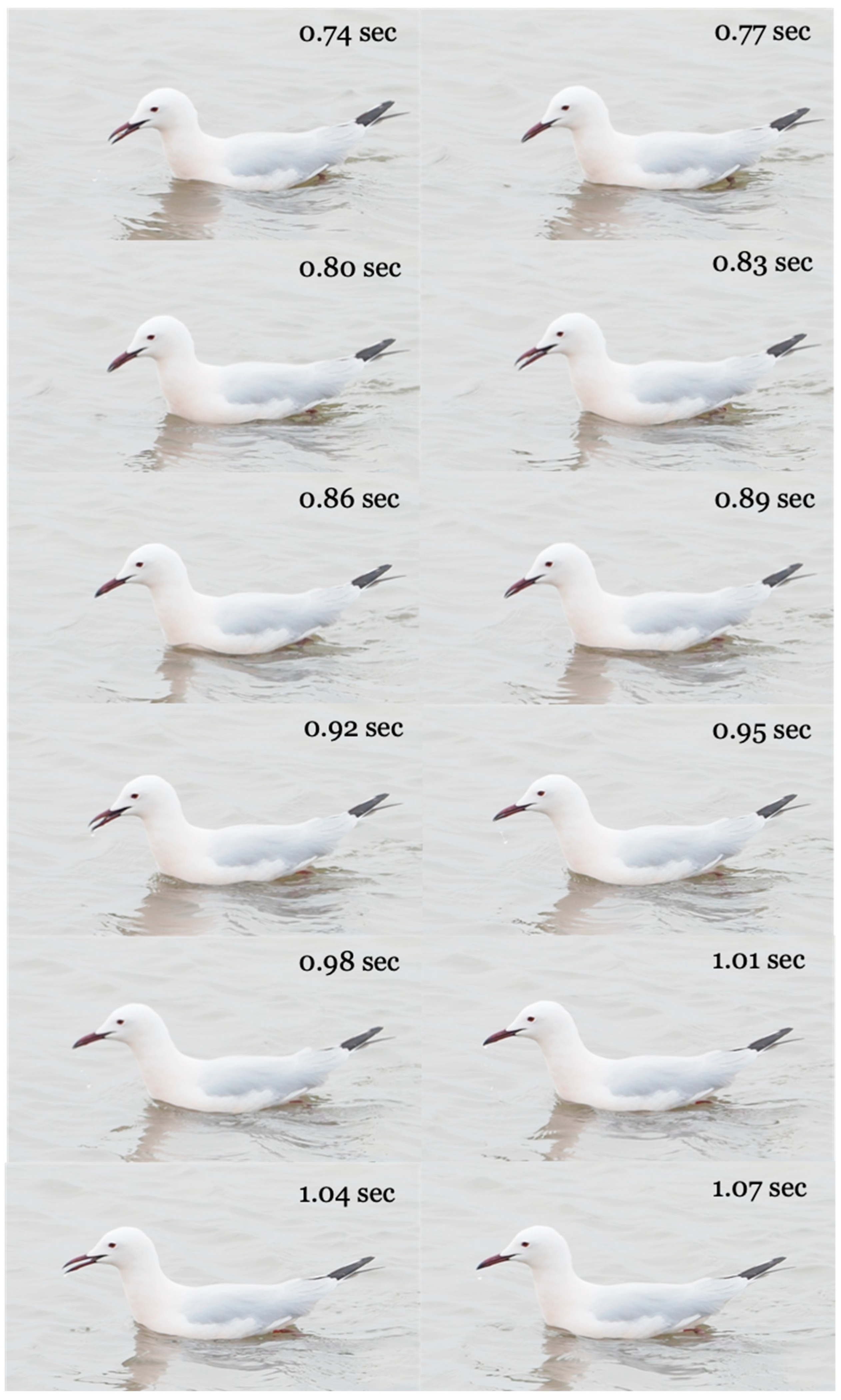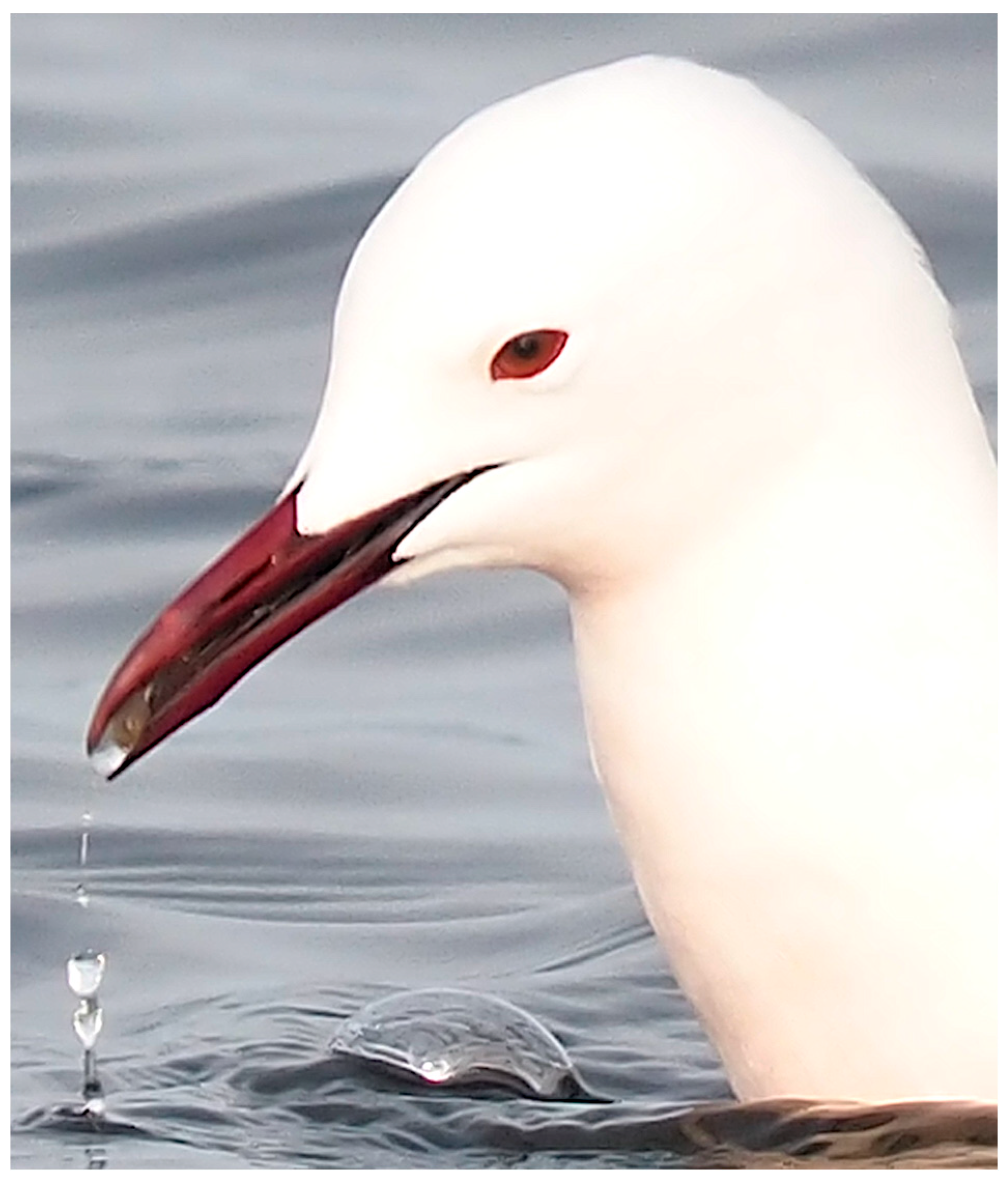Body Design or Behavior? What Explains the Performance of Slender-Billed Gulls (Chroicocephalus genei) Feeding on Brine Shrimp (Artemia sp.) in Salt Pans?
Simple Summary
Abstract
1. Introduction
2. Materials and Methods
2.1. Data Collection
2.2. Data Analysis
2.2.1. Intake Rate
2.2.2. Field Metabolic Rate
2.3. Behavioral Data
3. Results
3.1. Hourly Energy Intake Rate
3.2. Catching Time Needed to Cover the Energetic Requirement of FMR
3.3. Food Acquisition Behaviors
4. Discussion
5. Conclusions
Supplementary Materials
Author Contributions
Funding
Institutional Review Board Statement
Data Availability Statement
Conflicts of Interest
References
- Pigot, A.L.; Sheard, C.; Miller, E.T.; Bregman, T.P.; Freeman, B.G.; Roll, U.; Seddon, N.; Trisos, C.H.; Weeks, B.C.; Tobias, J.A. Macroevolutionary convergence connects morphological form to ecological function in birds. Nat. Ecol. Evol. 2020, 4, 230–239. [Google Scholar] [CrossRef]
- Xu, Y.; Price, M.; Que, P.; Zhang, K.; Sheng, S.; He, X.; Wen, Z.; Wang, B. Ecological predictors of interspecific variation in bird bill and leg lengths on a global scale. Proc. R. Soc. B 2023, 290, 20231387. [Google Scholar] [CrossRef]
- Arnold, S.J. Morphology, performance and fitness. Am. Zool. 1983, 232, 347–361. [Google Scholar] [CrossRef]
- Emerson, S.B.; Arnold, S.I. Intra- and interspecific relationships between morphology performance, and fitness. In Complex Organismal Functions: Integration and Evolution in Vertebrates; Wake, D.B., Roth, G., Eds.; Wiley and Sons: Chichester, UK, 1989; pp. 295–314. [Google Scholar]
- Irshick, D.J.; Higham, T.E. Animal Athletes: An Ecological and Evolutionary Approach; Oxford University Press: Oxford, UK, 2016; 255p. [Google Scholar]
- Green, P.A.; McHenry, M.J.; Rico-Guevara, A. Mechanoethology: The physical mechanisms of behavior. Integr. Comp. Biol. 2021, 61, 613–623. [Google Scholar] [CrossRef] [PubMed]
- Higham, T.E. The integration of locomotion and prey capture in vertebrates: Morphology, behavior, and performance. Integr. Comp. Biol. 2007, 47, 82–95. [Google Scholar] [CrossRef]
- Bels, V.L.; Pallandre, J.-P.; Pelle, E.; Kirchhoff, F. Studies of the behavioral sequences: The neuroethological morphology concept crossing ethology and functional morphology. Animals 2022, 12, 1336. [Google Scholar] [CrossRef] [PubMed]
- Higham, T.E.; Ferry, L.A.; Schmitz, L.; Irschick, D.J.; Starko, S.; Anderson, P.S.; Bergmann, P.J.; Jamniczky, H.A.; Monteiro, L.R.; Navon, D.; et al. Linking ecomechanical models and functional traits to understand phenotypic diversity. Trends Ecol. Evol. 2021, 369, 860–873. [Google Scholar] [CrossRef] [PubMed]
- Levitis, D.A.; Lidicker, W.Z., Jr.; Freund, G. Behavioural biologists do not agree on what constitutes behaviour. Anim. Behav. 2009, 78, 103–110. [Google Scholar] [CrossRef]
- Garland, T.J.; Losos, J.B. Ecological morphology of locomotor performance in squamate reptiles. In Ecological Morphology: Integrative Organismal Biology; Wainwright, P.C., Reilly, S.M., Eds.; The University of Chicago Press: Chicago, IL, USA, 1994; pp. 240–302. [Google Scholar]
- Pianka, E.R. Evolutionary Ecology; Harper Collins: New York, NY, USA, 1984; 486p. [Google Scholar]
- Higham, T.E.; Clark, R.W.; Collins, C.E.; Whitford, M.D.; Freymille, G.A. Rattlesnakes are extremely fast and variable when striking at kangaroo rats in nature: Three-dimensional high-speed kinematics at night. Sci. Rep. 2017, 7, 40412. [Google Scholar] [CrossRef]
- Burger, J.; Gochfeld, M. Family Laridae (Gulls). In Handbook of the Birds of the World, Vol. 3. Hoatzin to Auks; del Hoyo, J., Elliott, A., Sargatal, J., Eds.; Lynx Edicions: Barcelona, Spain, 1996; pp. 572–599. [Google Scholar]
- Cramp, S.; Simmons, K.E.L. The Birds of the Western Palearctic; Volume III. Waders to Gulls; Oxford University Press: Oxford, UK; New York, NY, USA, 1983; 913p. [Google Scholar]
- Götmark, F. Food and foraging in five European Larus gulls in the breeding season: A comparative review. Ornis Fenn. 1984, 61, 9–18. [Google Scholar]
- Méndez, A.; Montalvo, T.; Aymí, R.; Carmona, M.; Figuerola, J.; Navarro, J. Adapting to urban ecosystems: Unravelling the foraging ecology of an opportunistic predator living in cities. Urban Ecosyst. 2020, 23, 1117–1126. [Google Scholar] [CrossRef]
- Frixione, M.G.; Lisnizer, N.; Yorio, P. Year-round use of anthropogenic food sources in human modified landscapes by adult and young Kelp Gulls. Food Webs 2023, 35, e00274. [Google Scholar] [CrossRef]
- Navarro, J.; Martín-Vélez, V.; Giménez, J.; Antonio Garcia, J.; Cermeño, P.; Figuerola, J.; Aymí, R.; Montalvo, T. Ontogeny of foraging behaviour in an opportunistic gull inhabiting urban marine ecosystems. Wildl. Biol. 2024, e01406. [Google Scholar] [CrossRef]
- Raghav, S.; Boogert, N.J. Factors associated with herring gulls Larus argentatus stealing food from humans in coastal towns. Bird Study 2022, 69, 103–108. [Google Scholar] [CrossRef]
- Isenmann, P. Contribution à l’étude de la biologie de la reproduction et de l’étho-écologie du goéland railleur, Larus genei. Ardea 1976, 64, 48–61. [Google Scholar]
- Burger, J.; Gochfeld, M.; Garcia, E.F.J. Slender-billed Gull (Chroicocephalus genei), version 1.0. In Birds of the World; del Hoyo, J., Elliott, A., Sargatal, J., Eds.; Cornell Lab of Ornithology: Ithaca, NY, USA, 2020. [Google Scholar] [CrossRef]
- Britton, R.H.; Johnson, A.R. An ecological account of a Mediterranean salina: The Salin de Giraud, Camargue (S. France). Biol. Conserv. 1987, 42, 185–230. [Google Scholar] [CrossRef]
- Oro, D. Breeding biology and population dynamics of Slender-billed Gulls at the Ebro Delta (Northwestern Mediterranean). Waterbirds 2002, 25, 67–77. [Google Scholar] [CrossRef]
- Mason, D.T. The growth response of Artemia salina (L.) to various feeding regimes. Crustaceana 1963, 5, 138–150. [Google Scholar] [CrossRef]
- Dunn, R.E.; White, C.R.; Green, J.A. A model to estimate seabird field metabolic rates. Biol. Lett. 2018, 14, 20180190. [Google Scholar] [CrossRef]
- Baguette, M.; Le Floch, G.; Hannier, L.; Kirchhoff, F.; Schtickzelle, N.; Stevens, V.M.; Bels, V. Repertoire of food acquisition behaviors in Western Palearctic shorebirds (Aves, Charadriiformes). Front. Ethol. 2024, 3, 1351994. [Google Scholar] [CrossRef]
- Altmann, J. Observational study of behaviour: Sampling methods. Behaviour 1974, 49, 227–267. [Google Scholar] [CrossRef]
- Bradley, D.J.; Forward, R.B., Jr. Phototaxis of adult Brine shrimp, Artemia salina. Can. J. Zool. 1984, 56, 708–711. [Google Scholar] [CrossRef]
- Caudell, J.N.; Conover, M.R. Energy content and digestibility of Brine shrimp (Artemia franciscana) and other prey items of Eared Grebes (Podiceps nigricollis) on the Great Salt Lake. Biol. Conserv. 2006, 130, 251–254. [Google Scholar] [CrossRef]
- Cuellar, O. Ecology of Brine shrimp from Great Salt Lake, Utah, U.S.A. (Branchiopoda, Anostraca). Crustaceana 1990, 59, 25–34. [Google Scholar] [CrossRef]
- Tobias, J.A.; Sheard, C.; Pigot, A.L.; Devenish, A.J.M.; Yang, J.; Sayol, F.; Neate-Clegg, M.H.C.; Alioravainen, N.; Weeks, T.L.; Barber, R.A.; et al. AVONET: Morphological, ecological and geographical data for all birds. Ecol. Lett. 2022, 25, 581–597. [Google Scholar] [CrossRef]
- Burger, J.; Gochfeld, M. Bonaparte’s Gull (Chroicocephalus philadelphia), version 1.0. In Birds of the World; del Hoyo, J., Elliott, A., Sargatal, J., Eds.; Cornell Lab of Ornithology: Ithaca, NY, USA, 2020. [Google Scholar] [CrossRef]




| Individual | Sequence Reference | Duration (s) | Captures | Intake Rate (Capture/min) |
|---|---|---|---|---|
| 1 | 40071003 | 61 | 42 | 41.3 |
| 2 | 40071003 | 15 | 20 | 80 |
| 3 | 40071005 | 32 | 49 | 91.9 |
| 4 | 40071008 | 33 | 26 | 47.3 |
| 5 | 40071009 | 31 | 33 | 63.9 |
| 6 | 40071010 | 33 | 19 | 34.5 |
| 7 | 40071011 | 39 | 36 | 55.4 |
| 8 | 40071066 | 28 | 27 | 57.9 |
| 9 | 40071066 | 11 | 5 | 27.3 |
| 10 | 40071066 | 26 | 16 | 36.9 |
| 11 | 40071066 | 4 | 5 | 75 |
| 12 | 40071066 | 23 | 31 | 80.9 |
| 13 | 40071020 | 11 | 9 | 49.1 |
| 14 | 40080005 | 15 | 11 | 44 |
| 15 | 40080005 | 27 | 24 | 53.3 |
| 16 | 40080005 | 10 | 9 | 54 |
| 17 | 40080009 | 63 | 76 | 72.4 |
| 18 | 40080096 | 7 | 7 | 60 |
| 19 | 40080096 | 8 | 6 | 45 |
| 20 | 40080096 | 8 | 9 | 67.5 |
| 21 | 40080096 | 5 | 7 | 84 |
| Reproduction Phase | Field Metabolic Rate (kJ/Day) | Daily Time of Brine Shrimp Catching (h) |
|---|---|---|
| Incubation | 311.44 | 3.07 |
| Brood | 490.70 | 4.54 |
| Crèche | 556.01 | 5.34 |
| Species | Beak Length (mm) | Beak Depth (mm) | Length-Depth Ratio | Diet Composition |
|---|---|---|---|---|
| C. brunnicephalus | 47.4 | 11.1 | 4.3 | Fish, shrimp, insects, offal |
| C. bulleri | 41.5 | 7.9 | 5.2 | Fish, earthworms, insects, aquatic invertebrates, offal |
| C. cirrocephalus | 47.5 | 10.2 | 4.6 | Fish, invertebrates, eggs, kleptoparasitic, scavenger |
| C. genei | 52.1 | 9.4 | 5.5 | Fish, aquatic invertebrates including Artemia |
| C. hartlaubii | 39.5 | 8.9 | 4.4 | Generalist |
| C. maculipennis | 41.4 | 8.9 | 4.6 | Generalist |
| C. novaehollandiae | 39.6 | 10.2 | 3.9 | Generalist |
| C. philadelphia | 35.0 | 6.6 | 5.3 | Fish, insects |
| C. ridibundus | 43.4 | 7.9 | 5.5 | Generalist |
| C. serranus | 41.9 | 9.7 | 4.3 | Generalist |
Disclaimer/Publisher’s Note: The statements, opinions and data contained in all publications are solely those of the individual author(s) and contributor(s) and not of MDPI and/or the editor(s). MDPI and/or the editor(s) disclaim responsibility for any injury to people or property resulting from any ideas, methods, instructions or products referred to in the content. |
© 2025 by the authors. Licensee MDPI, Basel, Switzerland. This article is an open access article distributed under the terms and conditions of the Creative Commons Attribution (CC BY) license (https://creativecommons.org/licenses/by/4.0/).
Share and Cite
de Saint Seine, M.; Hannier, L.; Bels, V.; Schtickzelle, N.; Baguette, M. Body Design or Behavior? What Explains the Performance of Slender-Billed Gulls (Chroicocephalus genei) Feeding on Brine Shrimp (Artemia sp.) in Salt Pans? Biology 2025, 14, 1331. https://doi.org/10.3390/biology14101331
de Saint Seine M, Hannier L, Bels V, Schtickzelle N, Baguette M. Body Design or Behavior? What Explains the Performance of Slender-Billed Gulls (Chroicocephalus genei) Feeding on Brine Shrimp (Artemia sp.) in Salt Pans? Biology. 2025; 14(10):1331. https://doi.org/10.3390/biology14101331
Chicago/Turabian Stylede Saint Seine, Maud, Lyse Hannier, Vincent Bels, Nicolas Schtickzelle, and Michel Baguette. 2025. "Body Design or Behavior? What Explains the Performance of Slender-Billed Gulls (Chroicocephalus genei) Feeding on Brine Shrimp (Artemia sp.) in Salt Pans?" Biology 14, no. 10: 1331. https://doi.org/10.3390/biology14101331
APA Stylede Saint Seine, M., Hannier, L., Bels, V., Schtickzelle, N., & Baguette, M. (2025). Body Design or Behavior? What Explains the Performance of Slender-Billed Gulls (Chroicocephalus genei) Feeding on Brine Shrimp (Artemia sp.) in Salt Pans? Biology, 14(10), 1331. https://doi.org/10.3390/biology14101331







